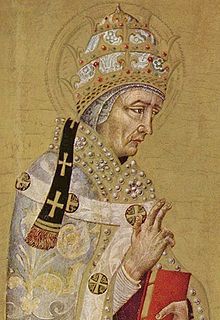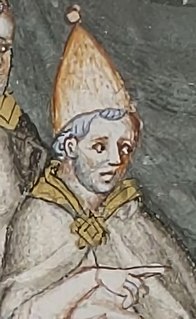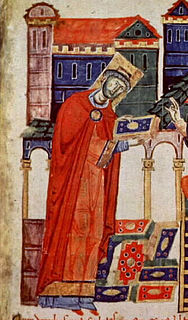Related Research Articles

Pope Alexander III, born Roland, was head of the Catholic Church and ruler of the Papal States from 7 September 1159 until his death. A native of Siena, Alexander became pope after a contested election, but had to spend much of his pontificate outside Rome while several rivals, supported by Holy Roman Emperor Frederick I Barbarossa, claimed the papacy. Alexander rejected Byzantine Emperor Manuel I Komnenos' offer to end the East–West Schism, sanctioned the Northern Crusades, and held the Third Council of the Lateran. The city of Alessandria in Piedmont is named after him.
Pope Anastasius IV, born Corrado Demetri della Suburra, was head of the Catholic Church and ruler of the Papal States from 8 July 1153 to his death. He is the most recent pope to take the name "Anastasius" upon his election.

Pope Callixtus II or Callistus II, born Guy of Burgundy, was head of the Catholic Church and ruler of the Papal States from 1 February 1119 to his death in 1124. His pontificate was shaped by the Investiture Controversy, which he was able to settle through the Concordat of Worms in 1122.

Pope Lucius III, born Ubaldo Allucingoli, reigned from 1 September 1181 to his death. Born of an aristocratic family of Lucca, prior to being elected pope, he had a long career as a papal diplomat. His papacy was marked by conflicts with Holy Roman Emperor Frederick I, his exile from Rome and the initial preparations for the Third Crusade.
Pope Damasus II was the head of the Catholic Church and ruler of the Papal States from 17 July 1048 to his death on 9 August that same year. He was the second of the German pontiffs nominated by Emperor Henry III. A native of Bavaria, he was the third German to become pope and had one of the shortest papal reigns.
Honorius II, born Pietro Cadalo, was an antipope from 1061 to 1072. He was born in the County of Verona, and became bishop of Parma in 1045. He died at Parma in 1072.
Callixtus III was an antipope from September 1168 until his resignation in August 1178. He was the third antipope elected in opposition to Pope Alexander III during the latter's struggle with the Emperor Frederick Barbarossa.
Gregory VIII, born Mauritius Burdinus, was antipope from 10 March 1118 until 22 April 1121.

Guibert or Wibert of Ravenna was an Italian prelate, archbishop of Ravenna, who was elected pope in 1080 in opposition to Pope Gregory VII and took the name Clement III. Gregory was the leader of the movement in the church which opposed the traditional claim of European monarchs to control ecclesiastical appointments, and this was opposed by supporters of monarchical rights led by the Holy Roman Emperor. This led to the conflict known as the Investiture Controversy. Gregory was felt by many to have gone too far when he excommunicated the Holy Roman Emperor Henry IV and supported a rival claimant as emperor, and in 1080 the pro-imperial Synod of Brixen pronounced that Gregory was deposed and replaced as pope by Guibert.
Theodoric was an antipope in 1100 and 1101, in the schism that began with Wibert of Ravenna in 1080, in opposition to the excesses of Pope Gregory VII and in support of the Emperor Henry IV.
Sylvester IV, born Maginulf, was a claimant to the Papacy from 1105 to 1111 in opposition to Paschal II. A priest before his election, he was probably a native of Rome. He had the backing of the Roman militia and initially of the Holy Roman Emperor, Henry IV, who later forced him to abdicate. Today he is regarded as an antipope.

Papal inauguration is a liturgical service of the Catholic Church within Mass celebrated in the Roman Rite but with elements of Byzantine Rite for the ecclesiastical investiture of a pope. Since the inauguration of Pope John Paul I, it has not included the 820-year-old (1143–1963) papal coronation ceremony.
Antipope Paschal III was a 12th-century clergyman who, from 1164 to 1168, was the second antipope to challenge the reign of Pope Alexander III. He had previously served as Cardinal of St. Maria.

The selection of the pope, the bishop of Rome and supreme pontiff of the Roman Catholic Church, prior to the promulgation of In nomine Domini in 1059 varied throughout history. Popes were often appointed by their predecessors or by political rulers. While some kind of election often characterized the procedure, an election that included meaningful participation of the laity was rare, especially as the popes' claims to temporal power solidified into the Papal States. The practice of papal appointment during this period would later result in the jus exclusivae, i.e., a right to veto the selection that Catholic monarchs exercised into the twentieth century.

The 1159 papal election following the death of Pope Adrian IV resulted in a double papal election. A majority of the cardinals elected Cardinal Rolando of Siena as Pope Alexander III, but a minority refused to recognize him and elected their own candidate Ottaviano de Monticelli, who took the name Victor IV, creating a schism that lasted until 1178.
The 1118 Papal Election was held to choose the successor for Pope Paschal II, who died in Rome on 21 January 1118, after an 18-year pontificate. Pope Gelasius II was elected as his successor. The election happened during the Investiture Controversy, a conflict between supporters of the Papacy and those of the Holy Roman Emperor. The election was held under the threat of possible violence due to the controversy. The Cardinal electors took refuge in the Benedictine monastery, S. Maria in Pallara, during the election. Within minutes of his election as pope, Gelasius II was attacked and imprisoned by the Frangipani faction, supporters of the Holy Roman Emperor. Gelasius managed to escape, but at the emperor's arrival with his army, he fled Rome and never returned.

The 1099 papal election following the death of Pope Urban II took place on 13 August 1099. Before his death, Urban had designated Cardinal Rainerius da Bieda as his successor. The cardinal-electors, with the consent of the lower Roman clergy, chose Rainerius, who, after a flight and over his considerable objections, accepted and took the name Paschal II. He was consecrated a bishop and crowned pope on the next day.

The 1086 papal election ended with the election of Desiderius, abbot of Monte Cassino as Pope Gregory VII's successor after a year-long period of sede vacante.
Giovanni Battista Mellini was an Italian Roman Catholic bishop and cardinal.
References
- 1 2 3 4 5
- Miranda, Salvador. "ALBERTO, O.S.B. (?-?)". The Cardinals of the Holy Roman Church. Florida International University Libraries. OCLC 53276621.
- 1 2 3 4 5 6 7 8 Andrea Piazza, "Alberto, antipapa", Enciclopedia dei Papi (Rome: 2000).
- 1 2 I. S. Robinson, Henry IV of Germany 1056–1106 (Cambridge University Press, 2000), p. 309.
- ↑ Steven A. Schoenig, Bonds of Wool: The Pallium and Papal Power in the Middle Ages (Catholic University of America Press, 2016), p. 358.